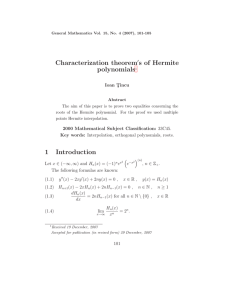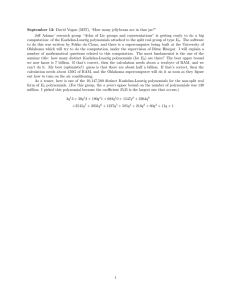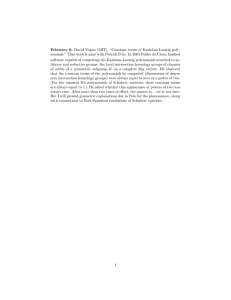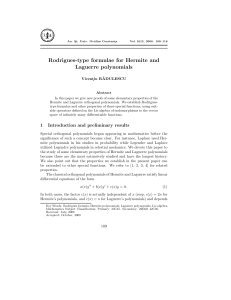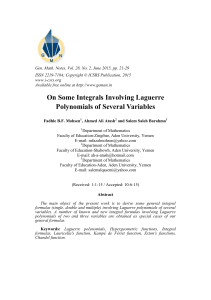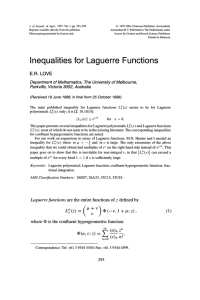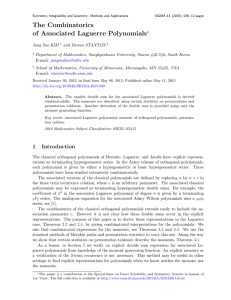The properties of Laguerre polynomials Ioan T ¸ incu 1
advertisement
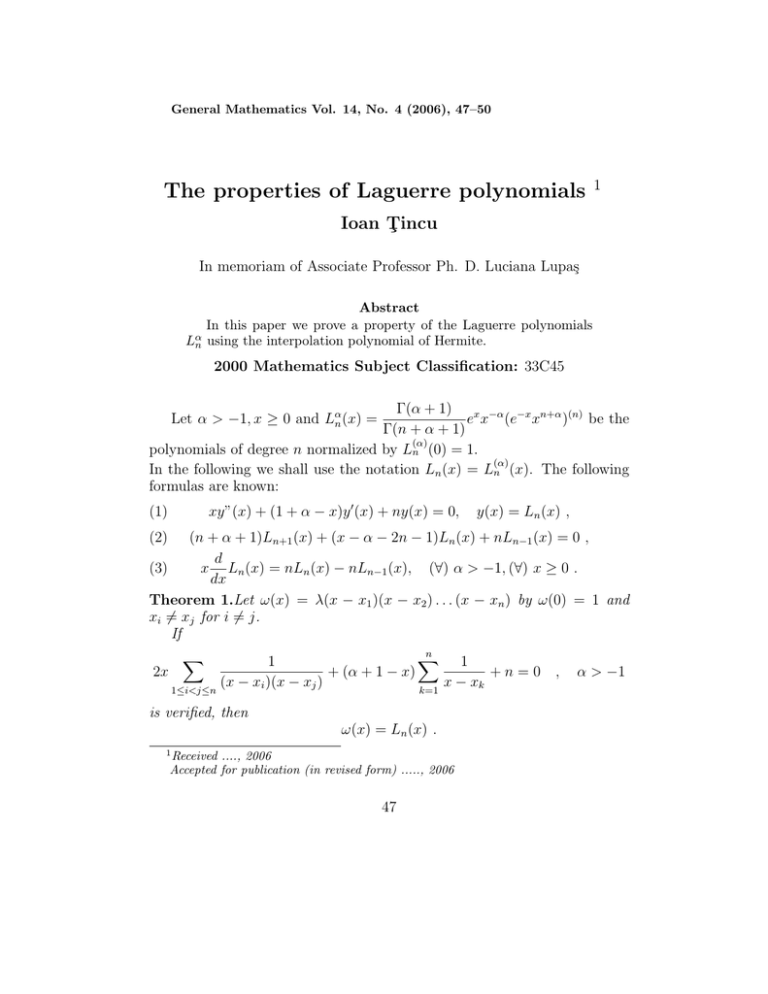
General Mathematics Vol. 14, No. 4 (2006), 47–50 The properties of Laguerre polynomials 1 Ioan Ţincu In memoriam of Associate Professor Ph. D. Luciana Lupaş Abstract In this paper we prove a property of the Laguerre polynomials Lαn using the interpolation polynomial of Hermite. 2000 Mathematics Subject Classification: 33C45 Γ(α + 1) x −α −x n+α (n) e x (e x ) be the Γ(n + α + 1) (α) polynomials of degree n normalized by Ln (0) = 1. (α) In the following we shall use the notation Ln (x) = Ln (x). The following formulas are known: Let α > −1, x ≥ 0 and Lαn (x) = xy”(x) + (1 + α − x)y ′ (x) + ny(x) = 0, (1) y(x) = Ln (x) , (2) (n + α + 1)Ln+1 (x) + (x − α − 2n − 1)Ln (x) + nLn−1 (x) = 0 , d x Ln (x) = nLn (x) − nLn−1 (x), (∀) α > −1, (∀) x ≥ 0 . (3) dx Theorem 1.Let ω(x) = λ(x − x1 )(x − x2 ) . . . (x − xn ) by ω(0) = 1 and xi 6= xj for i 6= j. If n X 1 1 + (α + 1 − x) +n=0 , (x − x )(x − x ) x − x i j k 1≤i<j≤n k=1 X 2x is verified, then ω(x) = Ln (x) . 1 Received ...., 2006 Accepted for publication (in revised form) ....., 2006 47 α > −1 48 Ioan Ţincu Proof. We consider ∆2n (x) = L2n (x) − Ln+1 (x)Ln−1 (x) and observe that ∆2n (0) = 0. According to Hermite interpolation formula ∆2n (x) = H2n (x1 x1 , x2 x2 , . . . , xn xn , c; ∆2n (x)) = · ¸2 n X Ln (x) ϕk (x) = ∆2n (c) + (x − c) Bk (∆2n ; x) Ln (c) xk − c k=1 where x1 , x2 , . . . , xn are the roots of Ln (x) and ¸2 Ln (x) , ϕk (x) = (x − xk )L′n (xk ) ¸ · 1 L′′n (xk ) ′ ∆2n (xk ) − ∆2n (xk ) . Bk (∆2n ; x) = ∆2n (xk )+(x−xk ) ∆2n (xk ) − ′ Ln (xk ) xk − c · For c = 0, we obtain ∆2n (0) = 0 , ¸2 n · X Ln (x) 1 2 ∆2n (x) = Ln (x)−Ln+1 (x)Ln−1 (x) = x · ·Bk (∆2n ; x)− ′ (x − xk )Ln (xk ) xk k=1 ¸2 n · X Bk (∆2n ; x) l Ln+1 (x) Ln−1 (x) . · =x · −1 − ′ Ln (x) Ln (x) (x − xk )Ln (xk ) xk k=1 Further, we investigate Bk (∆2n ; x). Observe that ∆2n (xk ) = −Ln+1 (xk )Ln−1 (xk ) . From (2) we have (4) Ln+1 (xk ) = − (5) ∆2n (xk ) = − n Ln−1 (xk ) n+α+1 n L2 (xk ) n + α + 1 n−1 ∆′2n (xk ) = −L′n+1 (xk )Ln−1 (xk ) − Ln+1 (xk )L′n−1 (xk ) . Using (2) and (3) one finds L′n+1 (xk ) = n+1 Ln+1 (xk ) , xk L′n−1 (xk ) = xk − α − n Ln−1 (xk ) . xk 49 The properties of Laguerre polynomials Therefore (6) n xk − α + 1 2 · Ln−1 (xk ) . n+α+1 xk From (1), (5) and (6) we obtain ∆′2n (xk ) = xk − α + 1 ∆′2n (xk ) = ∆2n xk xk (7) and 1 + α − xk L′′n (xk ) . =− ′ Ln (xk ) xk (8) By means (7), (8) we have ¸¾ ½ · ′ 1 ∆2n (xk ) L′′n (xk ) − − , Bk (∆2n ; x) = ∆2n (xk ) 1 + (x − xk ) ∆2n (xk ) L′n (xk ) xk Bk (∆2n ; x) = (9) x ∆2n (xk ) . xk Therefore ∆2n (x) = L2n (x) − Ln+1 (x)Ln−1 (x) = x n X k=1 1− L2n (x) x 2 · 2 ∆2n (xk ) , ′ [(x − xk )Ln (xk )] xk n X Ln+1 (x) Ln−1 (x) x 1 · 2 ∆2n (xk ) · =x 2 Ln (x) Ln (x) [(x − xk )L′n (xk )] xk k=1 From (3), we have (10) (11) (12) x L′ (x) Ln−1 (x) =1− · n Ln (x) n Ln (x) ¸ · ′ Ln+1 (x) Ln (x) x =1+ −1 . Ln (x) n + α + 1 Ln (x) xk Ln−1 (xk ) =− ′ Ln (xk ) n · ′ ¾ ¸¾ ½ ½ Ln (x) x L′n (x) x = −1 · 1− · 1− 1+ n + α + 1 Ln (x) n Ln (x) · ¸2 n X n Ln−1 (xk ) 1 2 = x · , nα + 1 k=1 (x − xk )2 L′n (xk ) 50 Ioan Ţincu · ¸2 n xX 1 α + 1 − x L′n (x) x L′n (x) +1= · + , n L(x) n Ln (x) n k=1 (x − xk )2 à n !2 n n α+1−xX 1 1 xX x X 1 + +1= , 2 n k=1 x − xk n x − x n (x − x k k) k=1 k=1 n X 1 1 + (α + 1 − x) +n=0 . 2x (x − x )(x − x ) x − x i j k 1≤i<j≤n k=1 X In conclusion ω(x) = Ln (x). References [1] G. Gasper, On the estension of Turan, s inequality to Jacobi polynomials, Duke Math. J. 38(1971), 415-428. [2] A. Lupaş, On the inequality of P. Turan for ultraspherical polynomials, Seminar of numerical and statistical calculus, University of Cluj-Napoca, Faculty of Mathematics, Research Seminaries, Preprint nr.4, 1985, 8287. [3] G. Szegö, Orthogonal Polynomials , Amer. Math. Soc. Providence, R.I. 1985. [4] I. Ţincu, A proof of Turan, s inequality for Laguerre polynomials, The 5th Romanian - German Seminar on Approximation Theory and its Applications, RoGer 2002, Sibiu. ”Lucian Blaga” University of Sibiu Faculty of Sciences Department of Mathematics Str. Dr. I. Raţiu, no. 5–7 550012 Sibiu - Romania E-mail address:
